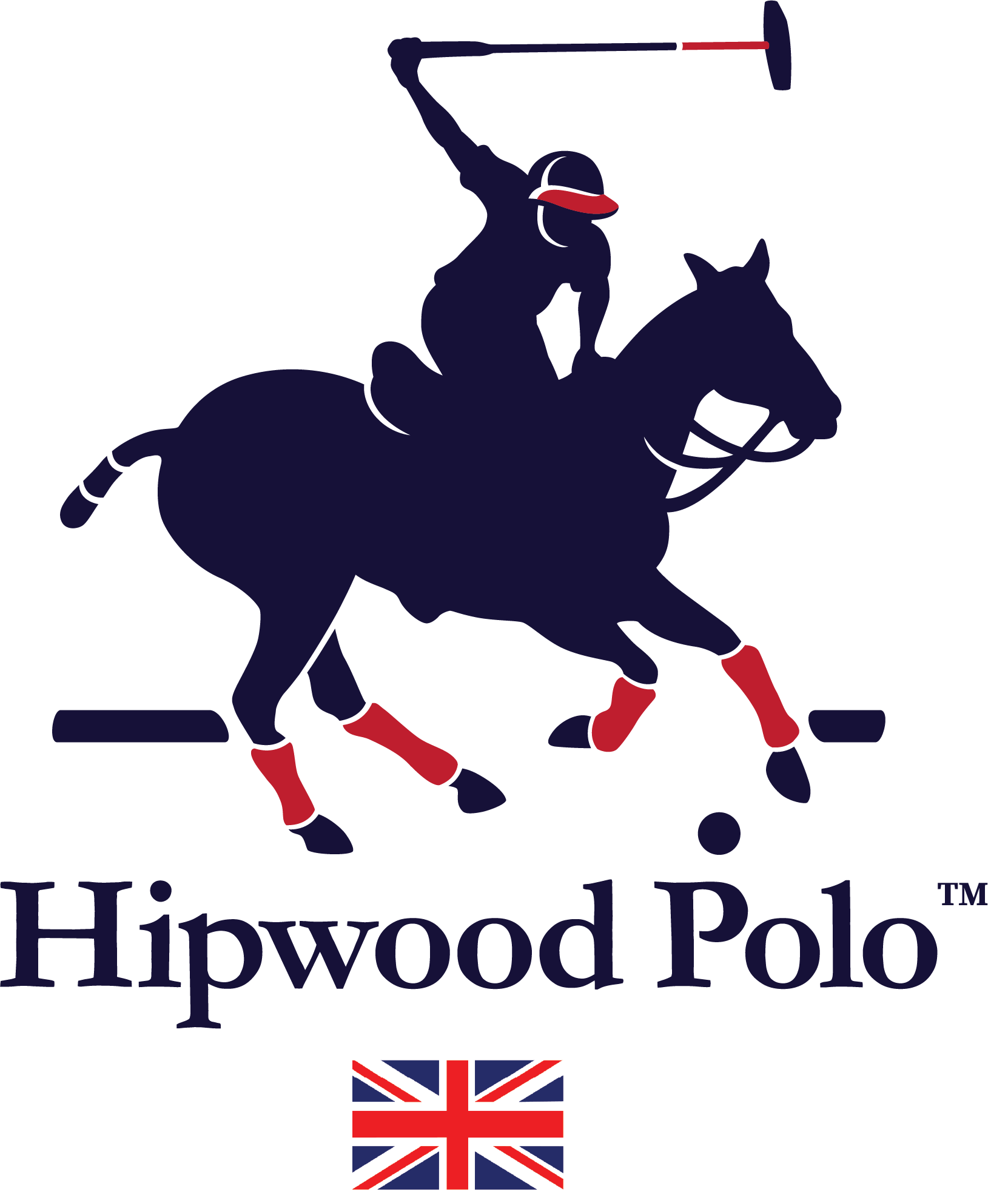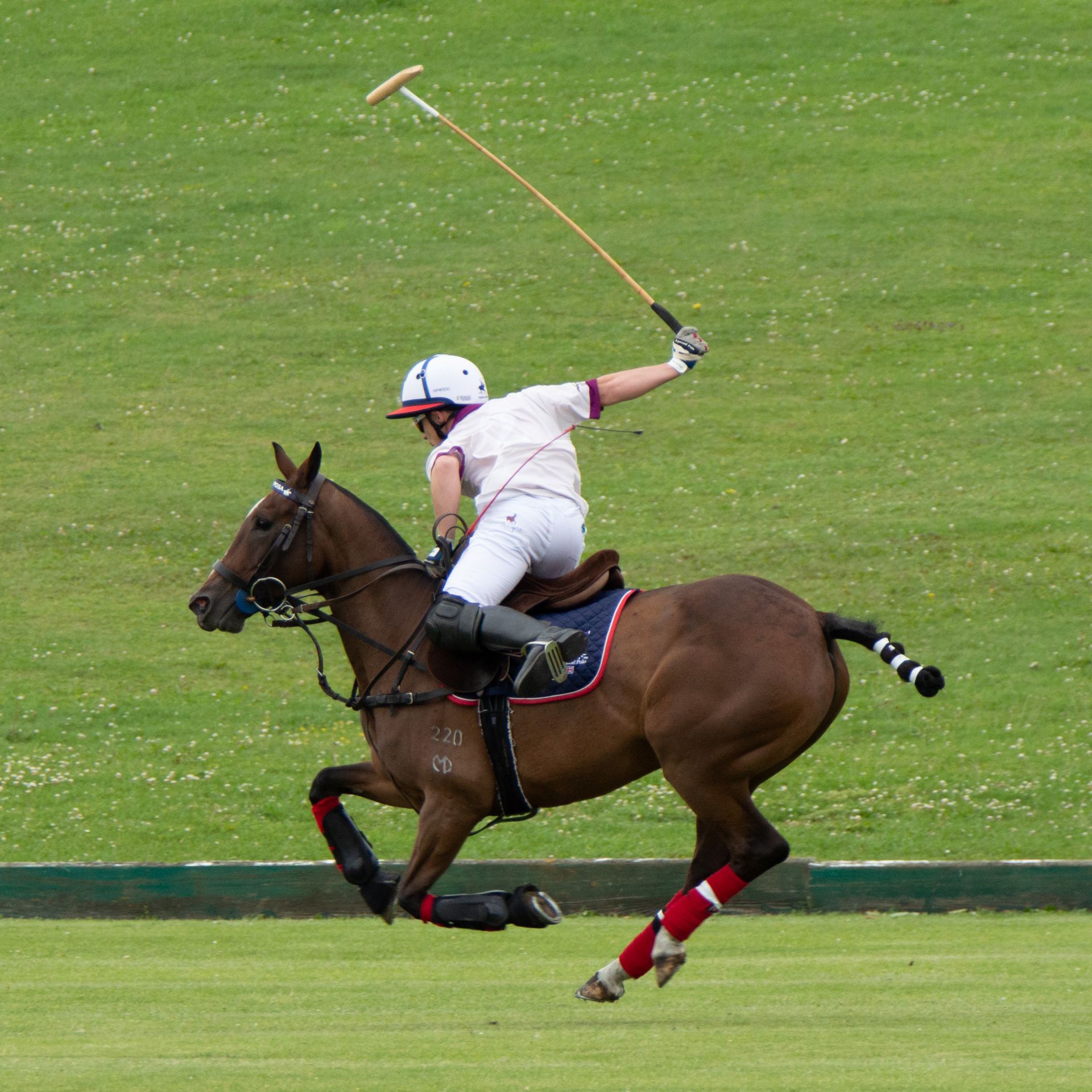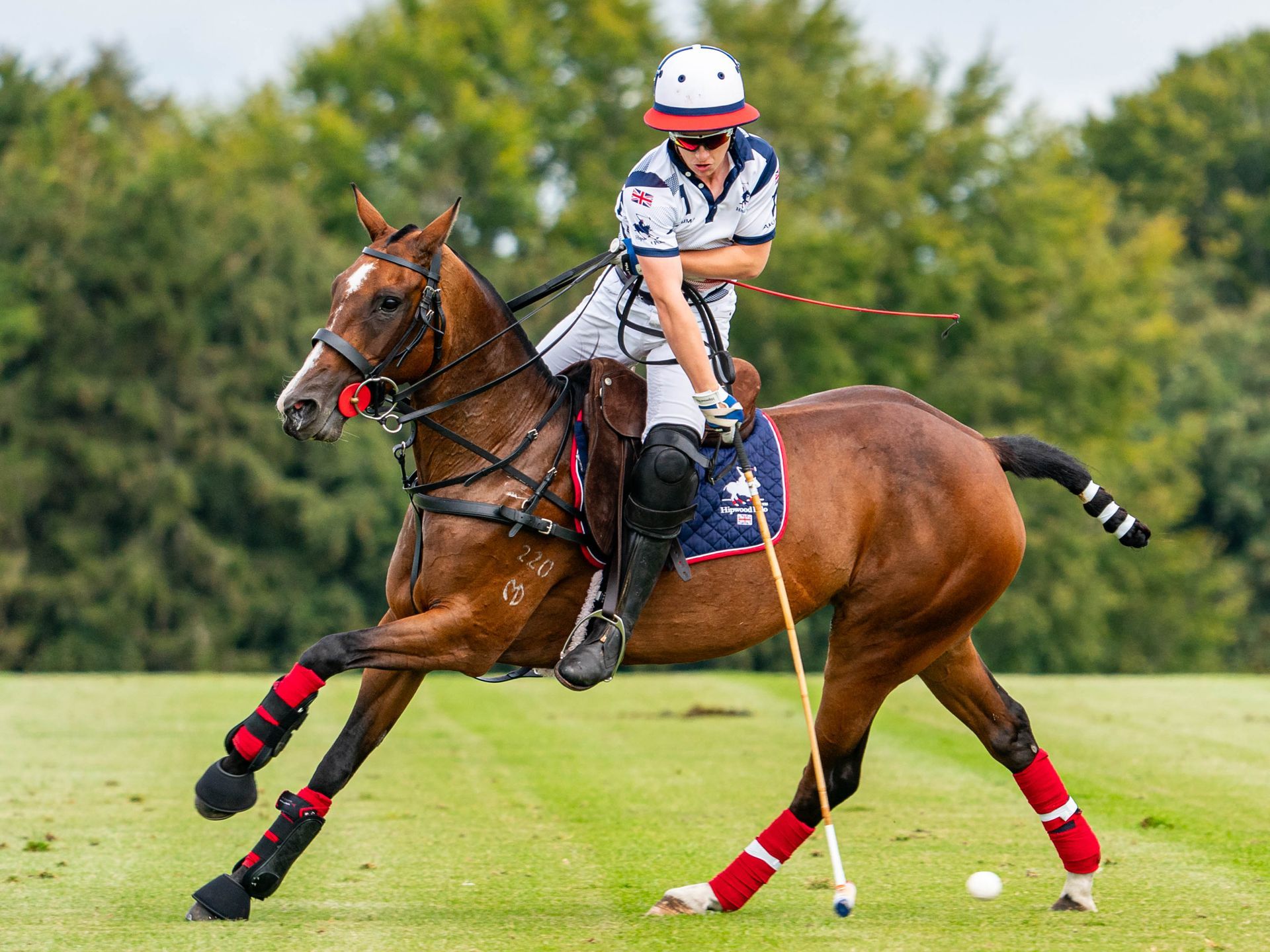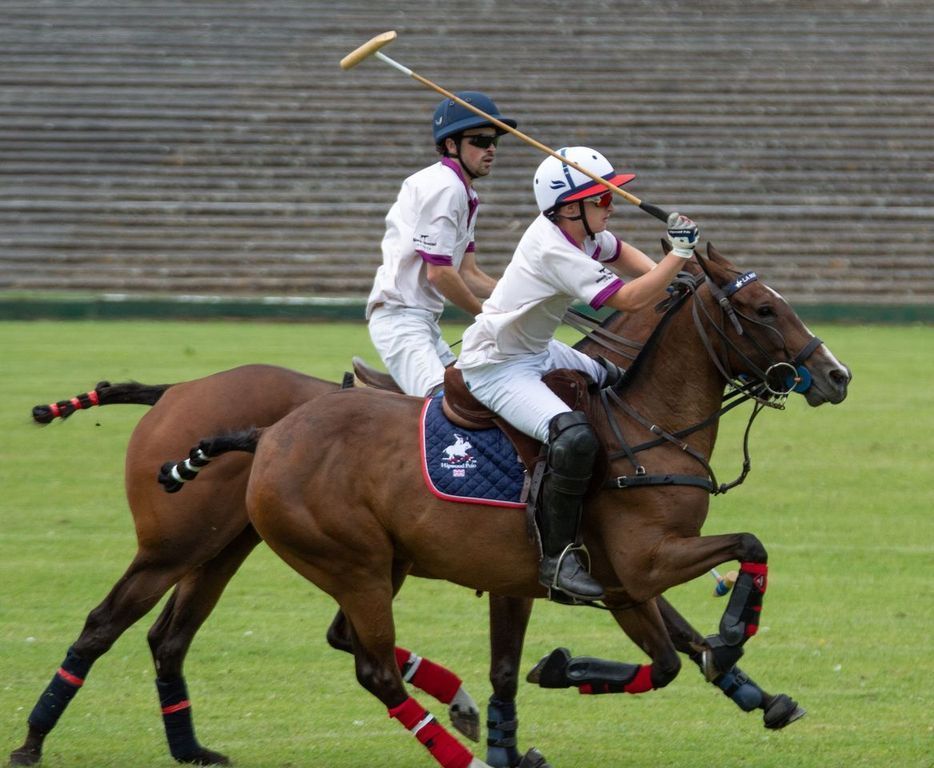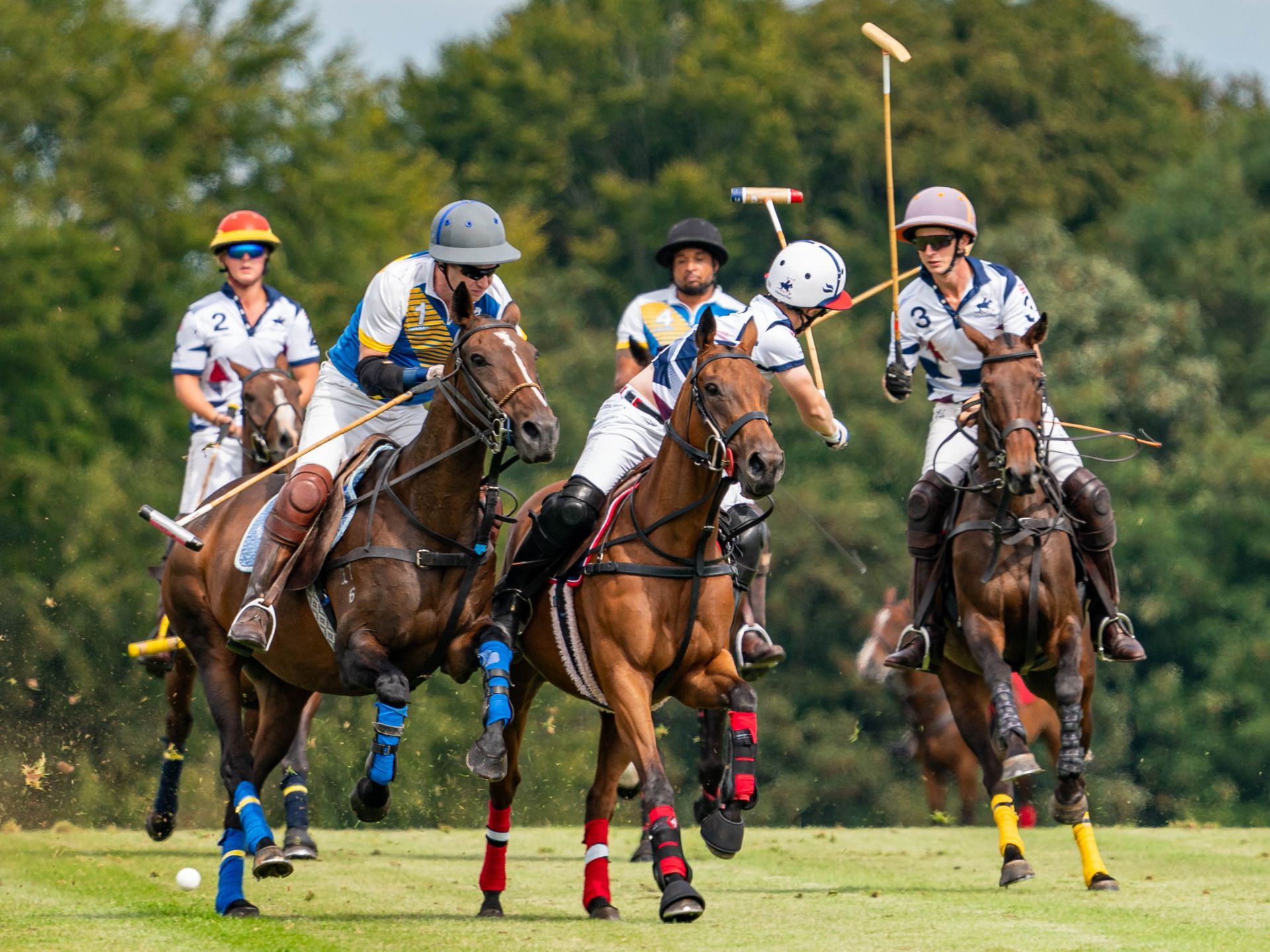Note this is section is constantly being updated and subject to change!
Full text available at https://hpa-polo.co.uk/download/2021-HPA-Rules-ONLY-WEB.pdf
Section 1: Preliminary Rules for the Game
1. Facilities and Access
Field of Play
= Prepared area bounded by side line or boards and back line
Safety Zone
= Prepared area 10 yard beyond side line and 30 yards back line
Goals
= 8 yards apart x 10ft high, must be light to knock down if knocked into
Goal Line
= back line between goals
Boards
= 11 inches heigh x 1 inch thick, may be curved at the ends
Ball
= 3-3.5 inch and 4.25-4.75oz in weight
Access during Play
= players, umpires and goal judges only except (1) stick chick in safety zone, (ii) player change in corner 'boxes' (iii) riding to pony lines safely within safety zone
2. Players
Team
= 4 players summer /
3 players winter in arena
Team Captain
= only person to speak with umpires
Right Hand Only
= Stick in right hand
Leaving the Field = Ask umpires first unless (i) stick (ii) change pony and (ii) legitimate run off
Drink and Drugs
= Dont do it!
Substitution
= must be similar player qualified to replace team, goal adjusted according to handicap
3. Players Equipment
Players to wear:
a) approved helmet and chinstrap
b) Polo boots and knee pads
c) Spurs (optional) but not ones that will wound a horse
d) No sharp projections
e) Goggles, elbow pads and gum shields (recommended)
f) Team shirts 1-4 (no duplicate numbers), Umpires only wear vertical black and white stripes
4. Ponies
a) Ponies of any height may play
b) No sick pony / blind pony / lame / unsafe / surgery pony
c) Ponies to wear bandages or boots on all four legs, tails up and no bad tack / blinkers / noseband / sharps / wire / projections
d) Shoes (optional - see a farrier), Studs on front shoes less than 0.5 inch cubes or hex, No nails, fancy spikes, protrusions etc
e) Lateral projection of shoe not more than 5mm of hoof wall
f) All or no shoes, hind shoes can be removed
5. Officials
Authority
= administered by 2 x umpires and referee
Referee
= third man in elevated and isolated position
Umpires
= 2 x mounted
Goal Judges
= 2 x one each end
Timekeeper
= may also act as scorer or assistant scorer
Scorer
= Records scores on board
Assistant Scorer
= prepares scoreboard before match
Section 2: Common Terms, Winning, Goals on Handicap and Scoring Goals, Duration and Start of Play
7. Common Terms
Foul
= any infringement of the rules
Ball in Play
= Thrown in when ball leaves umpires hands, Free hit when ball hit at or missed
Ball out of Play
= Goal scored, ball over back line or sides. A ball on line is still in play till whistle blown
Dead Ball
= Umpire blows whistle or bell at end of chukka
Break in Play
= when ball is either dead or out of play
Neutral
= Neither side advantaged
Throw in
= players stand 5 yd away from umpire next to imaginary line no less than 2ft apart
Offside
= when a player enters the field from side of opposing team during a throw in, penalty or hit in
Behind Ball
= the part of field behind the ball line of the attacking team
8. Winning, Goals on Handicap and scoring Goals
Winning
= team with most goals + handicap difference wins
Goals on Handicap
= each teams handicaps added together divided by chukkas, difference is awarded to lower handicap team
Scoring Goals
= ball passes between goals, not over it or lodged in goal post
Redress on Score
= any change to score must be made before final whistle
Undecided Goal
= Umpires consult referee then give benefit to defending team if in doubt
Whistle blown as Goal Scored
= (1) No foul occurs results in a goal, (2) Foul by Defending team results in a goal and (3) Foul by attacking team results in a penalty
9, 10, 11 and 12. Duration of Game, Unfinished Game, Duration of Chukkas and Start of Play
Number of Chukkas
= 6, excluding extra time
Intervals
= 3 minutes after all chukkas except half time 5 minutes after chukka 3
Unfinished Game
= Game must be played till finished unless stopped by umpire or the host tournament committee, recommence asap
Normal Chukka
= 7 mins, first bell with second '30 second' bell after 7.5 mins (max)
Final Chukka
= chukka usually ends after 7 minutes unless teams are tied, then 30 seconds and extra time if still no goal scored
Extra Time
= 1 x extra chukka to play till golden goal or sudden death
Start of Play
= Timekeeper to sound bell 5 minutes before start of play. Teams line up for throw in 20 yards from boards
Section 3: Interruptions and Restarts after breaks in Play
Changing Ends
= ends changed after every goal, play restarted with throw in unless Penalty 1 means play restarts with a Penalty 5b.
Other Changing Ends
= if no goal has been scored, players line up wrong way and umpires allow or extra time awarded
Attacker hits behind (Hit in / Knock in)
= for ball over back line, 4 yards from goal posts or boards, play within 10 seconds (see Penalties)
Defender hits behind safety sixty
= Penalty 6 (Safety 6) will be ordered by umpire (see Penalties). If deflection off another player it is a hit-in (Rule 15)
Ball hit out of play over boards or side line between 2 x 60 yard lines
= umpire shall place ball - no clock stops - opposing player to hit ball within 5 seconds
Ball hit out of play over boards or side line within 60 yard line at either end
= umpire shall place ball on 60 yard line - no clock stops - opposing player to hit ball within 5 seconds to team player (30 yd away) or shoot for goal
Restart after interval between chukkas
= Ball put into play in same manner as before interval unless ends changed
Restart when ball has no left field of play
= re-started with throw in on spot where whistle blown, facing near side line, 20 yard from boards or side line and 10 yard from back line
Buried or Damaged Ball
= Umpire whistle and throw in with replacement ball. Goal awarded for larger portion of ball through goal.
Lost Helmet or Broken Equipment
= umpire stop play when neutral or stop play where there is a safety risk. Player may be asked to leave field of play and game will commence without him
Dismounted Player
= A player may not dismount without good reason and if dismounted must not interfere with game or ball
Injured or Fallen Player
= Umpire stops game, when neutral or stop play where there is a safety risk. 10 minutes granted for player to recover or produce substitute. Umpire may allow additional time for a serious injury
Injured, distressed, fallen or fatigued pony or lost shoe = primary responsibility with player. Umpire may stop game and order all may change. Player risks play commencing after he has left field.Shoe changes at next break in play.
Section 4: Precedence and Personal Fouls
Crossing
= No player to cross another player with precedence except at a safe distance with no safety risk
Precedence between players as to whether they can play the ball
= determined by the 'line of the ball'.
Line of the Ball
= imaginary line where ball has travelling and ball is travelling, which is reference for deciding precedence between players(see diagrams in HPA book)
Possession of Ball
= A player with possession is entitled to travel down the line of the ball on offside subject to a legitimate opposition play
Ball Deflected
= If two players are on line of ball and the ball is defected to a new line, they must re-establish themselves on line and if not give way to any player on new line of ball
Changing Line of Ball = If player in possession creates new line of ball in direction of opposing player, that players must clear the line of ball and not make a play to avoid a foul
Hitting Past a Player
= an opposing player travelling at the same speed has a right to an offside play provided he does not cross any following player and the following player may not ride into him from behind.
Moving the Ball - One Tap Rule
- A player must keep the ball moving. Should he reduce to a walk he may tap the ball once only and then must hit it or run with it within 5 seconds
Turning and Play on the Boards
= The first player to the ball may not turn in front of a player on the line of the ball. He may make checks and where it is safe to turn he can continue play. The player once turned on the boards must keep playing in the new direction
Carrying the Ball
= A player may bot catch, kick or hit at the ball with anything but the stick. He may block with his body but not with an open hand. If the ball becomes carried, the umpire will restart with a throw in at the point the ball was first carried.
Hooking
= No hooking unless on the same side of the opponent's pony as the ball or in a direct line from behind. Stick hooks must be under shoulder. No hooking of a nearside backhand behind the player.
Riding off
= Must be at same speed, shoulder to shoulder at a safe angle. No pushing with head, hand, arm or elbow.
Blocking
= No blocking of an opponent attempting to make attempt to block making a play on the ball during a hit in after a break in play
Dangerous Riding or Play
= No use of stick to endanger a pony, player or other person. Umpires may award a yellow flag for dangerous play such as (1) ride off at dangerous angle or speed (2) ride offs over the back line endangering a goal judge (3) riding into the stick stroke of another player (4) zig-zagging in front of another player (5) pulling across another player (6) riding an opponent across another player endangering an umpire (7) sandwiching an opponent with another team player (8) riding to intimidate and cause another opponent to pull out or miss a stroke (9) use of stick improperly or dangerously, playing a full shot in a melee or ride off, windmill or helicopter
Unsportsmanlike Conduct
= Behaviour in such a way as to bring the game into disrepute. The following behaviours may lead to an umpire awarding a red or yellow flag:
a. Showing disrespect, using vulgar or abusive language or gestures, including continuing to appeal or argue with the umpires or officials, verbally, by gesture or with a stick
b. Seizing with the hand another player, their pony or equipment
c. Striking another player, their pony with a stick, whip, hand or fist.
d. Causing unnecessary delay that is unwarranted or advantageous to their own team before or during a game, whether or not the ball is out of play or dead
e. Feigning injury to a pony or as a player to get play stopped.
f. Refusing to continue to play or leaving the field without the umpire's permission except to change a pony, a stick or for a legitimate run off
g. Abuse of a pony such as using a whip when the ball is out of play, using a whip or spurs unnecessarily or hauling or jabbing a pony's mouth.
h. Hitting the ball intentionally or recklessly beyond the safety zone or when it is out of play or dead, in such a way that it could injure a spectator, official, or cause damage to property
Section 5: Penalties
Penalties must be taken within reasonable time, within 20 seconds of the Umpire dropping the ball
Penalty 1 - Goal Awarded
Goal awarded to fouled team for "Dangerous or deliberate foul" in goal area
Game resumed with Penalty 5b (centre) after changing ends
Penalty 2 – 30 YARD - Fouled captain chooses "a" or "b"
On spot OR Free Hit behind 30 Yard line (close to goal)for foul within 30 yard line
Fouled Team:
a. One Free hit (defended) on spot of foul. All team behind ball. Can hit twice.
Defending team:
• not within 30 yd of ball
• Behind back line
• Not to enter field via goal posts
Fouled Team:
b. One free hit (undefended) behind centre 30 yard line opposite goal. All team behind 30 yard line. Hitter can hit once. Free hit if rebounds
Defending team:
• Has no play
• Behind back line
• Not in goal
• No distractions
• Must allow ball to rest
Penalty 3 – 40 YARD
Free Hit behind centre 40 Yard line for foul within 40 yard line
Fouled Team:
One free hit (undefended) behind 40 yard line opposite goal – one stoke at goal. All team behind 40 yard line. Hitter can hit once. If he misses 2nd attempt is a half swing
Defending team:
• Behind back line until ball hit
• Not in goal
• Not to enter field via goal posts
Penalty 4 – 60 YARD
Free Hit behind centre 60 Yard line
Fouled team:
One free hit (defended) behind 60 yard line opposite goal – one stoke at goal. All team position as they wish. Hitter can hit once. If he misses 2nd attempt is a half swing
Defending team:
• Behind 30 yard line until ball hit
Penalty 5A - SPOT
Free Hit from spot where foul occurred, must be 4 yard from boards / side lines
Fouled team:
• Team free to position
Defending team:
• 30 yard from ball
• NOT behind ball
Penalty 5B - CENTRE
Free Hit from centre of field, must be 4 yard from boards / side lines
Fouled team:
• Team free to position
Defending team:
• 30 yard from ball
• NOT behind ball
Penalty 6 – SAFETY 60
Free Hit from 60 yard opposite where ball crossed back line, must be within 40 yards of centre
Fouled team:
• Team free to position
• One stoke intent to score
Defending team:
• Behind 30 yard line until ball hit
Penalty 7A – INFRINGEMENT PENALTY RETAKEN
Infringement by defending team facing hit
Infringement by both teams = Penalty re-taken
Penalty 5 moved up by 30 yards
Goal is awarded if defending team caused a foul preventing a goal
Penalty 7B – INFRINGEMENT
Fouled Team:
• awarded Penalty 5A spot and team free to position
Defending team:
• 30 yard from ball
• NOT behind ball
Penalty 8 – THROW IN
Umpire to throw ball towards nearest boards.
If there is a delay when taking a hit in see 15b.
Penalty 9A – PONY EQUIPMENT
Pony equipment infringement Pony sent off to rectify problem
Game resumes immediately
Penalty 9B – PLAYER EQUIPMENT
Player equipment infringement Pony sent off to rectify problem
Game resumes immediately
FLAGS
Flag for breach of rules
Usually for dangerous play, unsportsmanlike conduct, persistent breach of rules 2 x umpires must agree and consult with referee if undecided
Player and captain must acknowledge
SIN BIN / YELLOW FLAG
Yellow Flag = Player sent off for 2 minutes for first offence
2 x Yellow flags = automatic sin bin
Return to pony lines or designated area. When flag lowered may rejoin in an onside position
Can run over into 2 chukkas
If match ends, player can start next match in sin bin if committee decides
RED FLAG
Red flag = sent off for rest of match for first or second offence
Red Flag = for leaving field without umpire permission
Automatic if already sent off to sin bin and awarded a further yellow flag
A substitute of same or lower handicap can be made after 2 mins
Suspension from next match of tournament
Suspension can be increased by a disciplinary hearing
Suspension can apply to another match. Umpires to write report.
ACCUMULATION OF FLAGS
Totting up of flags Tournaments of 12 goal and above:
3 x Yellow Flags: Sin bin for fourth
5 Yellow Flags: Stood down for next match
6 Yellow Flags: Stood down for two matches
FLAG AFTER GAME
Yellow or Red flags can be awarded after the final whistle Yellow flag: starts next game on a yellow flag
Red flag: Red flag rules apply. Report of umpires.
Notice: These rules have been condensed as a quick reference guide and before taking the HPA Test you should read the current full version available online at: https://hpa-polo.co.uk/download/2021-HPA-Rules-ONLY-WEB.pdf
Also remember to read the supplementary rules.
Special Note:
Whip length (48cm), not using broken whips and whips to remain in players left hand together with reins at all times.
No spurs in the arena for 2019 winter season! (Not that any of you do ... )

